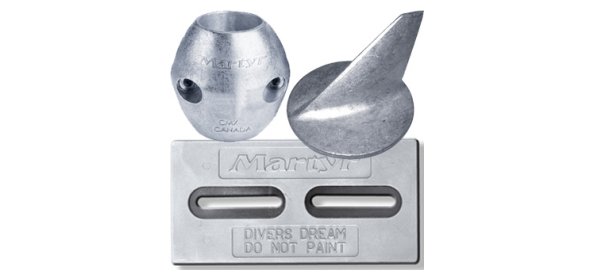Spring time is coming and with it a haul out and time to get your boat ready for the year. For many of us that means making hard choices: balancing a desire to use more environmentally friendly products against the need to protect our boat from the sea’s ability to quickly degrade it. The problem is that many of the tried and true materials work because of their toxicity – for instance Trinidad SR with its high copper content – and many of the new non-toxic products have not proven to work very well. Aluminum anodes MAY be an exception, a product that works better than traditional zinc anodes and is safer for the marine environment. From the Seattle based Clean Boating Foundation.
The Clean Boating Foundation is often asked by boaters about products they can use to reduce their environmental impact while enjoying their boat and the beautiful waters of Puget Sound. The three major responses are: cleaning supplies, non-copper bottom paint and aluminum/magnesium anodes. Let’s talk today about anodes.
What are anodes? They’re sacrificial lumps of metal attached to the bottom of your boat to prevent the wasting of the good metals of your boat (hull, shaft, propeller, etc) through galvanic corrosion. Basically, the anode corrodes before the boat does, saving you costly repairs and headaches – anodes are a good thing. Heard of Zincs? Zincs are anodes. But anodes don’t necessarily have to be zinc.
In fact, even though zinc has been the choice metal in traditional marine anodes for years, there are more effective and environmentally preferable (and sometimes less expensive) choices out there. The problem with zinc anodes, besides the fact that zinc itself is dangerous to the marine environment when it corrodes away into the water (it is actually regulated in Washington’s NPDES industrial and boatyard permits), is that they require cadmium as an activator for the galvanic protection process. Cadmium is an extremely toxic metal, regulated at the federal level. Bad stuff.
The other types of anodes to choose from are magnesium (for fresh water only – use it in saltwater for more than a few weeks and it’ll look like an alka- seltzer tablet) and aluminum (for salt or brackish water). Magnesium is relatively non-toxic to marine life – we eat the stuff as a vitamin supplement for Pete’s sake. It’s also highly reactive on the “galvanic scale,” making it suitable for the less-saline environment of lakes and rivers.
Aluminum is much less toxic than zinc and uses the relatively non-toxic indium as an activator and is therefore preferred over zinc from an environmental point of view. It’s also just as effective, if not more so, as a sacrificial anode. It’s been used in the offshore undersea industry for years to protect pipelines and other underwater installations – see this good article in Marine Log for more background information. The reason aluminum has been less used in the recreational-vessel anode world is that it’s taken the US Navy and the anode industry years to find the right alloy mixture to be truly effective. Well, they’ve got it down and you can now find any anode for your boat in aluminum. See http://www.martyranodes.com for more details – if they make it in zinc, they make it in aluminum.
Plus, aluminum weighs about half as much as zinc, helping with fuel efficiency as well as your back when pulling out your spares box. Just be aware that aluminum anodes corrode differently than zincs. Instead of the even pitted appearance of corroding zinc anodes, aluminum anodes tend to corrode in bigger chunks. Though it might look odd, the anode is working and should last even longer than your traditional zincs.
Ask your boatyard or retail store about aluminum anodes the next time you’re in for maintenance work. It just makes sense…and cents.
